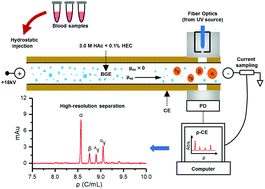A stable version of capillary electrophoresis for determining human hemoglobin chains aiming at the screening and diagnosis of thalassemia†
Abstract
As a fast, high-performance and cost-effective separation technique, capillary electrophoresis (CE) is applicable to the screening and diagnosis of diseases such as thalassemia. However, it is often not preferred due to its unrepeatable and/or irreproducible migration times. Herein, we propose a stable version of CE that uses migration charge density instead of the migration time to plot the electropherogram. The peak position is now independent of the applied voltage or current and the capillary geometry and is also insensitive to temperature. Its applicability was demonstrated in the quantitative analysis of human hemoglobin. On a laboratory-built device, with a running buffer simply consisting of 3.0 M acetic acid and 0.1% (w/v) hydroxyethyl cellulose, it allows a direct injection of whole blood samples and all the concerned globin chains, α, β, Aγ and Gγ can be well separated in 15 minutes. The resolution of α/β, β/Aγ, and Aγ/Gγ reached 4.4, 3.1 and 5.3, respectively. The intra- and inter-day precisions for the peak position based on the migration charge densities were below 0.6%. Its diagnostic applicability was validated in the analysis of several real blood samples from newborns, children and adults, and its capacity was demonstrated to screen and define the type of thalassemia.



 Please wait while we load your content...
Please wait while we load your content...